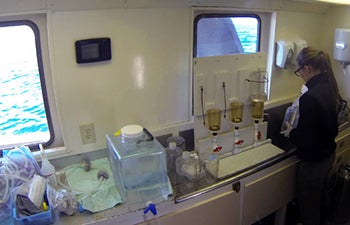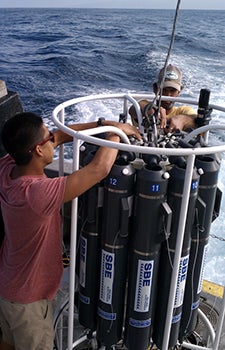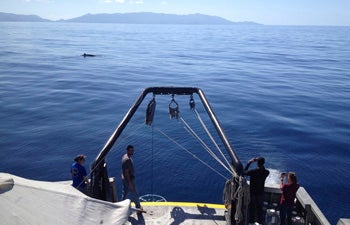A Scientific Hot SPOT
At a station in the San Pedro Basin, a region between Los Angeles Harbor and Catalina Island, USC Dornsife faculty and student researchers study the physical, biological and biogeochemical cycles that define the coastal ocean’s ecosystem.
Located 10 and a half miles offshore, the research site is called the San Pedro Ocean Timeseries (SPOT). Nearly two decades ago, the USC Wrigley Institute for Environmental Studies (WIES) founded the SPOT, which it has continually supported.
For much of that time, Jed Fuhrman, McCulloch-Crosby Chair in Marine Biology and professor of biological sciences, and David Caron, professor of biological sciences, have consistently received grants to conduct studies there. In all, the National Science Foundation’s (NSF) Microbial Observatories and Dimensions in Biodiversity programs have contributed $4.3 million.
At the coastal station, their research teams catalogue the dynamics and diversity of microbial populations. Teams include undergraduate and graduate students, and several Ph.D. theses in marine environmental biology and earth sciences have derived from research at the SPOT.
NSF has recently supported a major upgrade of the conductivity, temperature and depth instruments at the SPOT. The Rosette device allows researchers to collect samples and profile biological, chemical and physical parameters in the water.
Data is gathered on the water’s temperature, salinity, microbiological and chemical levels. Investigations are conducted as part of monthly measurements of the marine microbial community in a sea water column stretching from the ocean’s surface down to nearly 3,000 feet below sea level.
This research is crucial because understanding the structure, and seasonal and long-term variability of the microbial populations at the site contributes to a better understanding of the ocean in general and the effects of global climate change specifically. This is particularly important given that the SPOT is a marine setting that borders a densely populated major urban area, the greater Los Angeles Basin.

Aboard Yellowfin, doctoral student Paige Connell filters seawater samples to characterize microbial diversity patterns. Photo by Sarah Hu.
Recently, researchers at the SPOT have received nearly $3 million to continue their efforts.
A $2 million grant from the Gordon and Betty Moore Foundation will fund additional investigations and quarterly cruises for Fuhrman’s research team. This research aims to build a more holistic view of the microbial community by taking an integrative, interdisciplinary approach to the analyses.
“What usually happens in science is that people specialize in something,” Fuhrman said. “Everyone knows their specialty, but it’s difficult to know how everything fits together. With our Moore funding, we’re looking at viruses and the community of microorganisms including bacteria, archaea, protozoans and phytoplankton. We’re trying to see how they interact, hoping we’ll get better insights into how the system is controlled.”
Then this past summer, Doug Capone, William and Julie Wrigley Chair in Environmental Studies and professor and chair of biological sciences, received a competitive grant of nearly $1 million from NSF to study the nitrogen cycle at the SPOT station. This will be conducted in addition to the ongoing research by Fuhrman and Caron.
Capone, principal investigator for this research, is joined by Alyson Santoro of the University of Maryland and Xavier Mayali of Lawrence Livermore National Lab in Livermore, California.

Environmental studies undergraduate student Kieran Bartholow (left) and Troy Gunderson prep the water sampling aboard Yellowfin. Photo by Diane Kim.
“I’m very excited about this grant because it’s the first time I’ve gotten formal funding to work in the Southern California bight, and it really expands the repertoire of things we’re doing out there,” Capone said. “Plus, we’re going to be using some very state of the art tools.”
Capone’s project will examine rates of carbon fixation, the process by which marine organisms convert CO2 into organic carbon. He will study the uptake of nitrogen, which is often the factor limiting CO2 uptake. The project will also examine nitrification, another critical component of the nitrogen cycle performed by certain microorganisms.
With rising CO2 concentrations in the ocean and resulting decreases in surface water pH (a process known as ocean acidification), it is critical to understand the nutrient controls on the carbon cycle in coastal waters and the capacity of coastal ecosystems to sequester CO2.
Fuhrman will continue his research related to controls on microbial community composition and the relationships among groups of organisms. He and his research team have focused on how marine microbial communities respond to natural events and human-induced disturbances, observing how these communities adapt and function over time.
NSF funding in recent years has allowed for more detailed genetic analyses of these microbes. Genomics expert John Heidelberg, associate professor of biological sciences, was brought in along with computational biology specialists Fengzhu Sun, professor of biological sciences and mathematics, and head of USC Dornsife’s computational biology program, and Ting Chen, professor of biological sciences and computer science.
These researchers are taking a detailed look at genetics to understand microbe functions, explaining complex life-science processes in terms of the laws of physics and chemistry.

Researchers take a break onboard Yellowfin to greet a whale in the San Pedro Channel. Photo by David Needham.
Caron will continue his research to define the roles of protists in the ecology and biogeochemistry of aquatic ecosystems. Protists are a large and diverse group of eukaryotic microorganisms, which belong to the kingdom Protista. His work is focused on characterizing the diversity of communities of protists in various ecosystems around the world, establishing their basic physiologies, how they make a living and how fast they grow.
Linda Duguay, director of research for the USC Wrigley Institute, said the additional funding is a recognition of the importance of the SPOT site for oceanographic research in the urban ocean.
“We are committed to continuing our support of SPOT,” she said.
WIES Director Roberta Marinelli praised the research taking place at the SPOT.
“The only way to understand human impacts on climate and the coastal ocean is to study basic processes. How does our natural environment work and how do our actions affect it? The SPOT is a critical asset that allows us to answer these questions.”